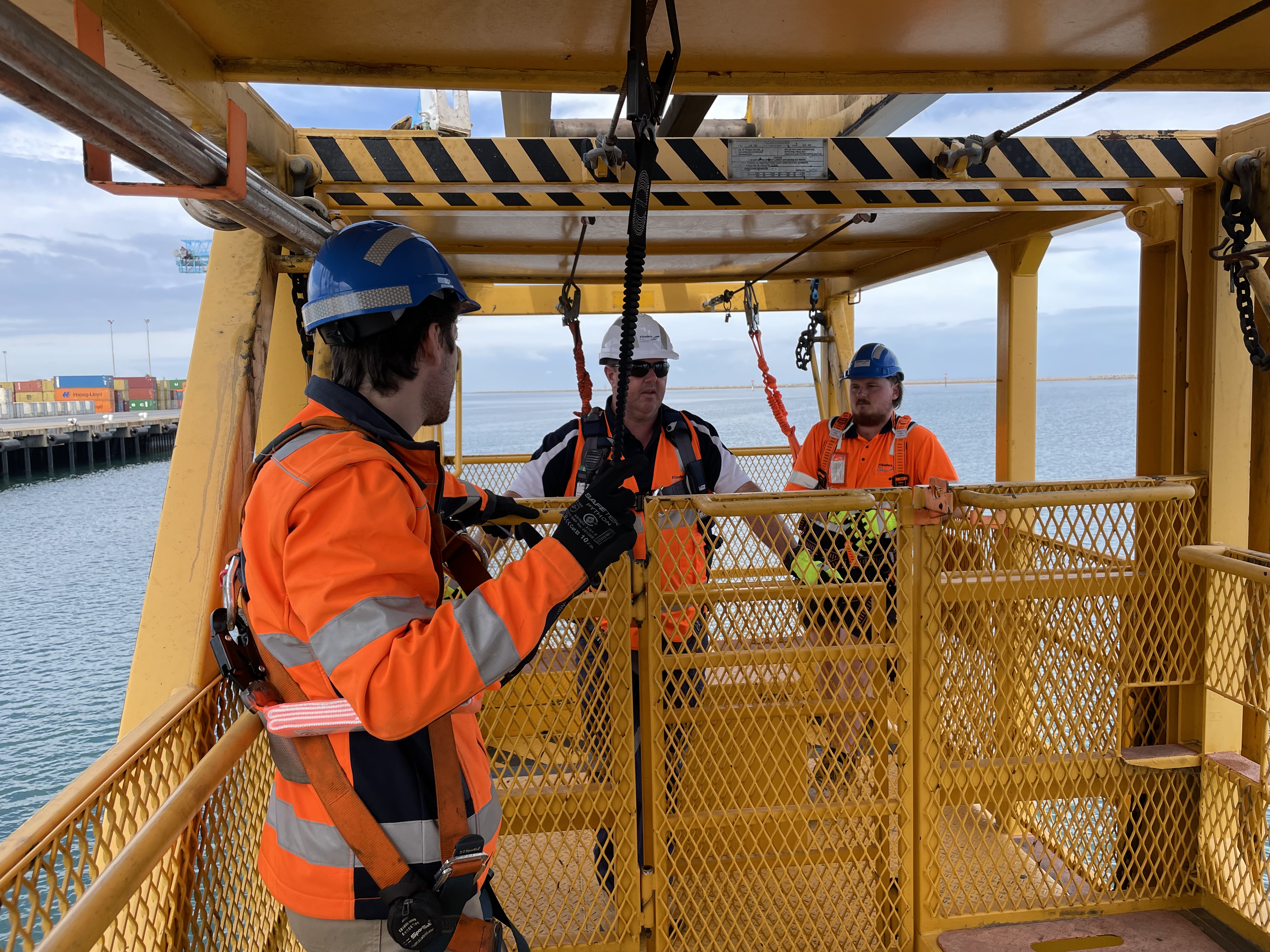Title Page
-
Document No.
-
Audit Title
-
Client / Site
-
Conducted on
-
Prepared by
-
Location
-
Personnel
Management and supervision of workplace transport risk
Management and supervision of workplace transport risk.
Check, in consultation with your employees, that your level of management control/supervision is adequate.
-
Are site rules documented and distributed?
-
Are supervisors, drivers and others, including visiting drivers and other contractors, aware of the site rules?
-
Are they aware of their responsibilities in terms of helping to maintain a safe workplace and environment?
-
Has a risk assessment been completed for workplace transport hazards?
-
Is the level of supervision sufficient to ensure that safe standards are maintained?
-
Are sanctions applied when employees, contractors, etc fail to maintain these standards?
-
Are adequate steps taken to detect unsafe behaviour of drivers of both site and visiting vehicles as well as pedestrians?
-
Are the underlying reasons investigated to correct safe behaviours?
-
Is there good co-operation and liaison on health and safety matters between your staff and those who collect and deliver goods?
Check what your drivers and other employees actually do when undertaking their work activities.
-
Do drivers drive with care, eg. use the correct routes, drive within the speed limit and follow other site rules?
-
Do your drivers and other employees have enough time to complete their work without rushing or working excessive hours?
-
Do you monitor"job and finish" work to ensure drivers are not rushing to cut corners?
-
Are your employees using safe work practices, eg. when (un)coupling, (un)loading, securing loads, carrying out maintenance, etc?
-
Do managers and supervisors routinely challenge and investigate unsafe behaviours they may come across?
-
Do managers and supervisors set a good example, for instance by obeying vehicle/pedestrian segregation instructions, and by wearing high visibility garments where they are needed?
Site layout and internal traffic routes
Site layout and internal traffic routes.
Check that the layout of the routes is appropriate.
-
Are the roads and foot ways suitable for the types and volumes of vehicular traffic and pedestrian traffic using them?
-
Are vehicles and pedestrians kept safely apart?
-
Where necessary, are there suitable pedestrian crossing places on vehicle routes?
-
Is there a safe pedestrian route that allows visiting drivers to report for instructions when entering the site?
-
Are there adequate numbers of suitable parking places for all vehicles and are they used?
-
Is there a properly designed and signed one way system used on vehicle routes within the workplace?
-
Is the level of lighting in each area sufficient for the pedestrian and vehicle activity?
Check that vehicle traffic routes are suitable for the type and quantity of vehicles which use them?
-
Are they wide enough?
-
Do they have firm and even surfaces?
-
Are they free from obstructions and other hazards?
-
Are they well maintained?
-
Do vehicle routes avoid sharp or blind bends?
Check that suitable safety features are provided where appropriate?
-
Are roadways marked where necessary, eg. to indicate the right of way at road junctions?
-
Are road signs, as used in the Highway Code, installed where necessary?
-
Are features such as fixed mirrors (to provide greater vision at blind bends), road humps (to reduce vehicle speed), or barriers (to keep vehicles and pedestrians apart) provided where necessary?
Vehicle selection and suitability
Check that vehicles are safe and suitable for the work for which they are being used.
-
Have suitable vehicles and attachments been selected for the tasks which are actually undertaken?
-
Do vehicles have good direct visibility or devices for improving vision where reversing cannot be eliminated and where significant risk still remains eg. external and side mirrors, vision aids such as CCTV or a sensing device?
-
Are they provided with horns, lights, reflectors, reversing lights and other safety features as necessary?
-
Do they have effective service and parking brakes?
-
Do they have seats and seat belts where necessary?
-
Are there guards to prevent access to dangerous parts of the vehicles, eg. power take offs, chain drives, exposed exhaust pipes?
-
Do drivers have protection against bad weather conditions, or against an unpleasant working environment, ie. the cold, dirt, dust, fumes and excessive noise and vibration?
-
Are there safe means of access to and from the cabs and other parts that need to be reached?
-
Are surfaces, where people walk on vehicles, slip resistant?
-
Is driver protection in the event of an overturn, and measures in place to prevent the driver being hit by falling objects, provided where necessary?
-
Are operators involved or consulted on vehicle selection?
Vehicle maintenance
Check the level of vehicle maintenance is adequate.
-
Is there a regular preventative maintenance program for every vehicle, carried out at predetermined intervals of time or mileage (eg. in accordance with manufacturers instructions
-
Is there a system for reporting faults on the vehicle and associated equipment and carrying out remedial work?
-
Where vehicle attachments lift people or objects, are thorough examinations undertaken by a competent person (eg insurance company)?
-
Do the drivers carry out basic safety checks before using the vehicle?
Vehicle movements
-
Have drive through, one way systems been used, wherever possible to reduce the need for reversing?
-
Where reversing areas are needed are they marked to be clear to both drivers and pedestrians?
-
Are non essential personnel excluded from areas where reversing occurs?
-
If a risk assessment shows site controls cannot be improved further and you need a banks man to direct reversing vehicles, are they adequately trained?
Un(loading) Activities
-
Are loading/unloading operations carried out in an area away from passing traffic, pedestrians and others not involved in the loading or unloading process?
-
Are the load(s), the delivery vehicles and the handling vehicle compatible with each other?
-
Are unloading/loading activities carried out on ground that is flat, firm and free from potholes?
-
Are parking brakes always used on trailers and traction units to prevent unwanted movement. E.g when coupling vehicles?
-
Are the vehicles braked and/or stabilised, as appropriate, to prevent unsafe movements during the loading and unloading operations?
-
Are systems in place to prevent trucks driving away whilst they are still being loaded/unloaded?
-
Are lorry drivers and others kept in a safe place away from the vehicles whilst unloading/ loading?
-
Is there a safe area marked where drivers can observe loading (if necessary)?
-
Has the need for people to go on the load area of the vehicle been eliminated where possible, and if not is safe access provided?
-
Is appropriate lifting equipment available for loading/unloading vehicles?
-
Is loading/unloading carried out so that, as far as possible, the load is spread evenly to avoid the vehicle or trailer becoming unstable?
-
Are checks made to ensure the load is adequately secured in line with the department for transport code of practice and not loaded beyond their capacity before the vehicle leaves site
Driver Competence
-
Do drivers possess the necessary licences or certificates for the vehicles they are authorised to drive. E.g FLTs, shunt vehicles etc?
-
Do you check the experience of your drivers and assess them to ensure they are competent?
-
Do you provide site specific training on how to perform the job, and information about particular hazards, speed limits, the appropriate parking and loading areas etc?
-
Do you have a planned programme or refresher training for drivers and others to ensure their continued competence?











